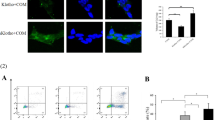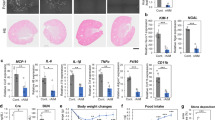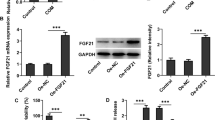Abstract
Surgical crushing of stones alone has not addressed the increasing prevalence of kidney stones. A promising strategy is to tackle the kidney damage and crystal aggregation inherent in kidney stones with the appropriate therapeutic target. FKBP prolyl isomerase 5 (FKBP5) is a potential predictor of kidney injury, but its status in calcium oxalate (CaOx) kidney stones is not clear. This study attempted to elucidate the role and mechanism of FKBP5 in CaOx kidney stones. Lentivirus and adeno-associated virus were used to control FKBP5 expression in a CaOx kidney stone model. Transcriptomic sequencing and immunological assays were used to analyze the mechanism of FKBP5 deficiency in CaOx kidney stones. The results showed that FKBP5 deficiency reduced renal tubular epithelial cells (RTEC) apoptosis and promoted cell proliferation by downregulating BOK expression. It also attenuated cell–crystal adhesion by downregulating the expression of CDH4. In addition, it inhibited M1 polarization and chemotaxis of macrophages by suppressing CXCL10 expression in RTEC. Moreover, the above therapeutic effects were exerted by inhibiting the activation of NF-κB signaling. Finally, in vivo experiments showed that FKBP5 deficiency attenuated stone aggregation and kidney injury in mice. In conclusion, this study reveals that FKBP5 deficiency attenuates cell–crystal adhesion, reduces apoptosis, promotes cell proliferation, and inhibits macrophage M1 polarization and chemotaxis by inhibiting NF-κB signaling. This provides a potential therapeutic target for CaOx kidney stones.








Similar content being viewed by others
Data availability
The raw data of RNA-seq were shown in Supplementary Information 2. Other data will be made available on request.
References
Zeng G, Mai Z, Xia S et al (2017) Prevalence of kidney stones in China: an ultrasonography based cross-sectional study. BJU Int 120:109
Abufaraj M, Xu T, Cao C et al (2021) Prevalence and trends in kidney stone among adults in the USA: analyses of National Health and Nutrition Examination Survey 2007–2018 Data. Eur Urol Focus 7:1468
Khan SR, Pearle MS, Robertson WG et al (2016) Kidney stones. Nat Rev Dis Primers 2:16008
Keddis MT, Rule AD (2013) Nephrolithiasis and loss of kidney function. Curr Opin Nephrol Hypertens 22:390
Li L, Lou Z, Wang L (2011) The role of FKBP5 in cancer aetiology and chemoresistance. Br J Cancer 104:19
Zannas AS, Jia M, Hafner K et al (2019) Epigenetic upregulation of FKBP5 by aging and stress contributes to NF-kappaB-driven inflammation and cardiovascular risk. Proc Natl Acad Sci USA 116:11370
Hartmann J, Bajaj T, Klengel C et al (2021) Mineralocorticoid receptors dampen glucocorticoid receptor sensitivity to stress via regulation of FKBP5. Cell Rep 35:109185
Xu H, Wang Z (2022) MicroRNA-23a-3p ameliorates acute kidney injury by targeting FKBP5 and NF-kappaB signaling in sepsis. Cytokine 155:155898
Lawrence T (2009) The nuclear factor NF-kappaB pathway in inflammation. Cold Spring Harb Perspect Biol 1:a001651
Bouwmeester T, Bauch A, Ruffner H et al (2004) A physical and functional map of the human TNF-alpha/NF-kappa B signal transduction pathway. Nat Cell Biol 6:97
Avellino R, Romano S, Parasole R et al (2005) Rapamycin stimulates apoptosis of childhood acute lymphoblastic leukemia cells. Blood 106:1400
Liu H, Ye T, Yang X et al (2019) H19 promote calcium oxalate nephrocalcinosis-induced renal tubular epithelial cell injury via a ceRNA pathway. EBioMedicine 50:366
Okada A, Nomura S, Higashibata Y et al (2007) Successful formation of calcium oxalate crystal deposition in mouse kidney by intraabdominal glyoxylate injection. Urol Res 35:89
Miller AW, Choy D, Penniston KL et al (2019) Inhibition of urinary stone disease by a multi-species bacterial network ensures healthy oxalate homeostasis. Kidney Int 96:180
Renkema KY, Lee K, Topala CN et al (2009) TRPV5 gene polymorphisms in renal hypercalciuria. Nephrol Dial Transplant 24:1919
Vezzoli G, Terranegra A, Aloia A et al (2013) Decreased transcriptional activity of calcium-sensing receptor gene promoter 1 is associated with calcium nephrolithiasis. J Clin Endocrinol Metab 98:3839
Liu H, Yang X, Tang K et al (2020) Sulforaphane elicts dual therapeutic effects on renal inflammatory injury and crystal deposition in calcium oxalate nephrocalcinosis. Theranostics 10:7319
Polanco J, Reyes-Vigil F, Weisberg SD et al (2021) Differential spatiotemporal expression of type I and type II cadherins associated with the segmentation of the central nervous system and formation of brain nuclei in the developing mouse. Front Mol Neurosci 14:633719
Liang X, Lai Y, Wu W et al (2019) LncRNA–miRNA–mRNA expression variation profile in the urine of calcium oxalate stone patients. BMC Med Genom 12:57
Li Y, Lu X, Yu Z et al (2023) Meta-data analysis of kidney stone disease highlights ATP1A1 involvement in renal crystal formation. Redox Biol 61:102648
Ding T, Zhao T, Li Y et al (2021) Vitexin exerts protective effects against calcium oxalate crystal-induced kidney pyroptosis in vivo and in vitro. Phytomedicine 86:153562
Vandenabeele P, Bultynck G, Savvides SN (2023) Pore-forming proteins as drivers of membrane permeabilization in cell death pathways. Nat Rev Mol Cell Biol 24:312
Khan SR, Canales BK, Dominguez-Gutierrez PR (2021) Randall’s plaque and calcium oxalate stone formation: role for immunity and inflammation. Nat Rev Nephrol 17:417
Tokunaga R, Zhang W, Naseem M et al (2018) CXCL9, CXCL10, CXCL11/CXCR3 axis for immune activation—a target for novel cancer therapy. Cancer Treat Rev 63:40
Zhang J, Liu Y, Chen H et al (2022) MyD88 in hepatic stellate cells enhances liver fibrosis via promoting macrophage M1 polarization. Cell Death Dis 13:411
Chen Y, Li C, Duan S et al (2019) Curcumin attenuates potassium oxonate-induced hyperuricemia and kidney inflammation in mice. Biomed Pharmacother 118:109195
Schrezenmeier EV, Barasch J, Budde K et al (2017) Biomarkers in acute kidney injury—pathophysiological basis and clinical performance. Acta Physiol (Oxf) 219:554
Miller I, Min M, Yang C et al (2018) Ki67 is a graded rather than a binary marker of proliferation versus quiescence. Cell Rep 24:1105
Ming S, Tian J, Ma K et al (2022) Oxalate-induced apoptosis through ERS-ROS-NF-kappaB signalling pathway in renal tubular epithelial cell. Mol Med 28:88
van den Berg TK, Kraal G (2005) A function for the macrophage F4/80 molecule in tolerance induction. Trends Immunol 26:506
Yu S, Yu M, Bu Z et al (2020) FKBP5 exacerbates impairments in cerebral ischemic stroke by inducing autophagy via the AKT/FOXO3 pathway. Front Cell Neurosci 14:193
Sidibeh CO, Pereira MJ, Abalo XM et al (2018) FKBP5 expression in human adipose tissue: potential role in glucose and lipid metabolism, adipogenesis and type 2 diabetes. Endocrine 62:116
Sheng X, Jung T, Wesson JA et al (2005) Adhesion at calcium oxalate crystal surfaces and the effect of urinary constituents. Proc Natl Acad Sci USA 102:267
Ceresa D, Alessandrini F, Bosio L et al (2019) Cdh4 down-regulation impairs in vivo infiltration and malignancy in patients derived glioblastoma cells. Int J Mol Sci 20:4028
Abhishek A, Benita S, Kumari M et al (2017) Molecular analysis of oxalate-induced endoplasmic reticulum stress mediated apoptosis in the pathogenesis of kidney stone disease. J Physiol Biochem 73:561
Liang T, Chen J, Xu G et al (2022) STAT1 and CXCL10 involve in M1 macrophage polarization that may affect osteolysis and bone remodeling in extrapulmonary tuberculosis. Gene 809:146040
Tozawa K, Yasui T, Okada A et al (2008) NF-kappaB activation in renal tubular epithelial cells by oxalate stimulation. Int J Urol 15:924
Chen T, Wang Y, Xu Z et al (2019) Epstein–Barr virus tegument protein BGLF2 inhibits NF-kappaB activity by preventing p65 Ser536 phosphorylation. FASEB J 33:10563
Funding
This work was supported by the National Natural Science Foundation of China (No. 82070723) and (No. 82270797).
Author information
Authors and Affiliations
Contributions
SXY, LJX, and QLS designed the research and wrote the manuscript; QLS, CS, XC, LJL, and WBL performed the experiments; CS, WBL, and LJX analyzed data; QLS, XC, CS, and YHX performed the animal model, and performed critical reading/editing of the manuscript; SXY and LJX supervised the study.
Corresponding authors
Ethics declarations
Conflict of interest
The authors have declared that no conflict of interest exists.
Ethical approval
The animal experiments in this study were approved by the Animal Ethics Committee of the Renmin Hospital of Wuhan University (Issue No. 20221008A).
Informed consent
Not applicable.
Additional information
Publisher's Note
Springer Nature remains neutral with regard to jurisdictional claims in published maps and institutional affiliations.
Supplementary Information
Below is the link to the electronic supplementary material.
Rights and permissions
Springer Nature or its licensor (e.g. a society or other partner) holds exclusive rights to this article under a publishing agreement with the author(s) or other rightsholder(s); author self-archiving of the accepted manuscript version of this article is solely governed by the terms of such publishing agreement and applicable law.
About this article
Cite this article
Song, Q., Song, C., Chen, X. et al. FKBP5 deficiency attenuates calcium oxalate kidney stone formation by suppressing cell–crystal adhesion, apoptosis and macrophage M1 polarization via inhibition of NF-κB signaling. Cell. Mol. Life Sci. 80, 301 (2023). https://doi.org/10.1007/s00018-023-04958-7
Received:
Revised:
Accepted:
Published:
DOI: https://doi.org/10.1007/s00018-023-04958-7




